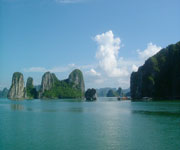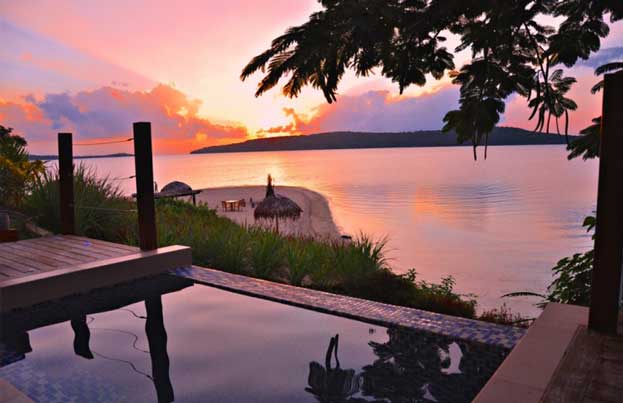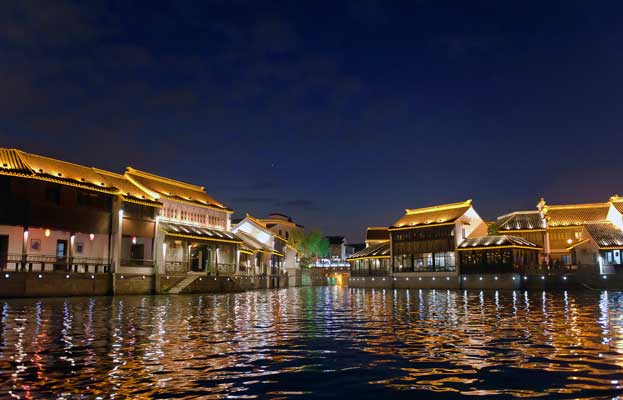China's Grand Canal, the world's longest and oldest artificial waterway, could be added to the UNESCO World Heritage List in 2014 with the help of a new campaign launched by the Shandong provincial government. Starting in Beijing in the north, the 1,747-kilometer-long canal passes through Tianjin as well as the provinces of Hebei, Shandong, Jiangsu and Zhejiang before reaching the city of Hangzhou in the south. The canal's oldest sections can be traced back 2,500 years, and they were linked together in the Sui Dynasty (581-618). It connects China's five major rivers - the Yellow River, the Haihe River, the Huai River, the Yangtze River and the Qiantang River.
Want to read UNESCO Daily News Updates? Click
Here!!!Truth behind Grand Canal
As a major water route for business over the centuries, it is now dotted with numerous ancient buildings and cultural relics, including not only ancient docks and ship locks but also business streets, temples, and former residences of past celebrities along the riverside. To better protect them, the Chinese central government put the canal on the list of key cultural relics under national protection and began to apply for world heritage status for it in 2009.
As an important part of the canal, the waterway in Shandong runs 570 kilometers across five cities, including Zaozhuang, Jining, Tai'an, Liaocheng and Dezhou. According to the Shandong Cultural Relics Bureau, five sections of the canal that lie within the five cities and 61 cultural heritage sites along them have been included on a tentative list of application for World Heritage Status.
"The preservation of the canal is crucial in its application efforts. We'll do our best to protect the rich natural and cultural resources along these sections," said Sun Shiqin, deputy director of the bureau. "Preparations are well under way, including improving the water quality, repairing ancient buildings, archaeological investigation and excavations as well as drafting nomination files," he said.
A feasible protection plan has been unveiled and special offices have been designated to coordinate canal conservation among different departments in the five cities.
A 2 square kilometer ancient town of Taierzhuang surrounded by the waterway in Zaozhuang has been restored. As a transport hub and thriving trading center, the town dates back to 2,000 years ago and was once praised by Emperor Qianlong of the Qing Dynasty (1636-1912) as the "No 1 town under heaven".
It is also the site of the Battle of Taierzhuang, an important victory during the Anti-Japanese War (1937-1945), and some buildings in the town were destroyed during the battle.
Since 2008, a total of 2.7 billion ($424.7million) yuan has been allocated to restoring the town to its previous glory. It now has some classical bridges, an old water transport system, wetland parks, temples, museums, and an architectural complex of a bygone era, which attract more than 1.5 million visitors annually.
An archaeological park project was also launched last June to protect the historic sites of the delicately designed hydraulic works in Wenshang county of Jining. Built in 1411, the hydraulic works, which have high scientific and artistic value, were said to be a wonder in Chinese architectural history.
Additionally, Liaocheng, the once-thriving commercial center in North China, is planning to invest 3.8 billion yuan to restore the city's image as the "Canal Capital of Northern China", by building a Canal Culture Museum of China and repairing the historical relics along the canal.
Browse All UNESCO World Heritage Sites in
China. The original Source
File!!!






 Megiddo was an important city in the Canaanite and Israelite periods because of its strategic location at the head of a pass through the Carmel Ridge. The city played a particularly important role during the reign of King Solomon and is mentioned a dozen times in the Tanakh. Some Christians believe it to be the site of Armageddon, where the battle marking the end of days is supposed to take place.
Megiddo was an important city in the Canaanite and Israelite periods because of its strategic location at the head of a pass through the Carmel Ridge. The city played a particularly important role during the reign of King Solomon and is mentioned a dozen times in the Tanakh. Some Christians believe it to be the site of Armageddon, where the battle marking the end of days is supposed to take place. St Kilda does not have any permanent residents.The largest island in the archipelago, Hirta was occupied until 1930 when the last islanders left after they asked to be evacuated because their way of life was no longer sustainable.Last year, evidence of a permanent settlement was uncovered on another, smaller island. Previously it was thought Boreray was only visited by islanders to hunt seabirds and gather wool from sheep.
St Kilda does not have any permanent residents.The largest island in the archipelago, Hirta was occupied until 1930 when the last islanders left after they asked to be evacuated because their way of life was no longer sustainable.Last year, evidence of a permanent settlement was uncovered on another, smaller island. Previously it was thought Boreray was only visited by islanders to hunt seabirds and gather wool from sheep.










 Gazprom's construction project, which now goes by the name "Lakhta Center", was previously referred to as "Okhta Center". "In June 2011, we took part in public hearings in which all concerned citizens of St. Petersburg could express their comments and proposals," reports Svetlana Afanasyeva, the PR director of the Okhta Public and Business Center Company. Following the hearings, the Committee for City Planning and Architecture issued a directive, which allowed for the construction of objects of up to 500 meters in height at another location, on the new Lakhta site. In November 2011, the St. Petersburg City Court affirmed the legitimacy of this directive; representatives of the future skyscraper received a construction permit after the project had also been agreed upon by Russia's State Expert Evaluation Department.
Gazprom's construction project, which now goes by the name "Lakhta Center", was previously referred to as "Okhta Center". "In June 2011, we took part in public hearings in which all concerned citizens of St. Petersburg could express their comments and proposals," reports Svetlana Afanasyeva, the PR director of the Okhta Public and Business Center Company. Following the hearings, the Committee for City Planning and Architecture issued a directive, which allowed for the construction of objects of up to 500 meters in height at another location, on the new Lakhta site. In November 2011, the St. Petersburg City Court affirmed the legitimacy of this directive; representatives of the future skyscraper received a construction permit after the project had also been agreed upon by Russia's State Expert Evaluation Department.
 The Heart of Neolithic Orkney World Heritage Site comprises Maeshowe, the Stones of Stenness, the Barnhouse settlement, Skara Brae prehistoric village and the famous standing stones of the Ring of Brodgar. In addition to the tomb, images of the Orkney stone circles and standing stones were also recorded by the Scottish Ten team.
The Heart of Neolithic Orkney World Heritage Site comprises Maeshowe, the Stones of Stenness, the Barnhouse settlement, Skara Brae prehistoric village and the famous standing stones of the Ring of Brodgar. In addition to the tomb, images of the Orkney stone circles and standing stones were also recorded by the Scottish Ten team.
 Speaking to press members at the mosque, Oguz said a structure had to be unique to be included in the UNESCO list. "We think the Esrefoglu Mosque deserves to be included in the world heritage list," he said. "It is a historic structure and very unique one. We hope that the mosque, which is currently included in the temporary list, will move to the permanent list, and we will keep this issue on the agenda," Oguz said.
Speaking to press members at the mosque, Oguz said a structure had to be unique to be included in the UNESCO list. "We think the Esrefoglu Mosque deserves to be included in the world heritage list," he said. "It is a historic structure and very unique one. We hope that the mosque, which is currently included in the temporary list, will move to the permanent list, and we will keep this issue on the agenda," Oguz said.



 To celebrate the 40th anniversary of the signing of the Convention Concerning the Protection of the World Cultural and Natural Heritage this year and support its principles, Panasonic has further strengthened its partnership with the NGC to sponsor the new TV series. Called "Access 360° World Heritage," which was newly commissioned to the NGC for productions, the program will focus on the sites of natural and cultural heritage around the world and illustrate the work to protect and conserve these sites, including the latest technologies and people that support the work behind the scenes. It will be broadcast from September 2012 to May 2013.
To celebrate the 40th anniversary of the signing of the Convention Concerning the Protection of the World Cultural and Natural Heritage this year and support its principles, Panasonic has further strengthened its partnership with the NGC to sponsor the new TV series. Called "Access 360° World Heritage," which was newly commissioned to the NGC for productions, the program will focus on the sites of natural and cultural heritage around the world and illustrate the work to protect and conserve these sites, including the latest technologies and people that support the work behind the scenes. It will be broadcast from September 2012 to May 2013. "For this, we need dialogue and mutual respect. Libya's future prospects depend on its inhabitants' ability to build a participatory democracy that respects the rights and the heritage of all its citizens." Several Muslim shrines have been attacked in recent days, including those of the mystic Sufi strand of Islam. Islamist hardliners on Saturday bulldozed part of the mausoleum of Al-Shaab Al-Dahman, close to the centre of the Libyan capital.
"For this, we need dialogue and mutual respect. Libya's future prospects depend on its inhabitants' ability to build a participatory democracy that respects the rights and the heritage of all its citizens." Several Muslim shrines have been attacked in recent days, including those of the mystic Sufi strand of Islam. Islamist hardliners on Saturday bulldozed part of the mausoleum of Al-Shaab Al-Dahman, close to the centre of the Libyan capital.


%20Lg.jpg)


























